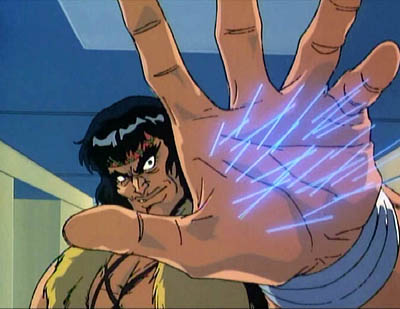Baoh hails from 1989, when the anime industry never wanted for short, hyper-violent, direct-to-video projects torn from vapid manga or the hallucinations of over-privileged animators. It was a world that gave rise to such delectable pulp as Cyber City Oedo 808 and the gloriously awful Angel Cop. Perhaps that makes up for this same period giving us things like Baoh.
Things actually open with a lick of suspense, as a young girl and her pom-tailed pet koala-squirrel run from car to car on a passenger train, pursued by a blue-haired woman and two security guards. Her escape attempt dead-ends when she stumbles into a train car occupied by a team of scientists and a large coffin-like tank. As the guards start to drag the girl away, the tank bursts open, revealing a young man clad only in leather straps and wires. The scientists' bald, mustached leader barely has the chance to bark out “We've awakened Baoh!” before the now-named Baoh emerges from his stasis, dispatches a security guard, and leaps off of the train, running into the newly escaped girl.
The passage of several months finds the girl, an orphan named Sumire, on the run with the young man, who's now wearing clothes and suffering from an amnesia that permits him to recall only his name: Ikuro Hashizawa. The two of them are now hunted by Doress, an ominous organization that experimented on Ikuro and snatched Sumire to study her psychic abilities.
Meanwhile, the bald scientist, Dr. Kasuminome, is busy giving his superiors at Doress a demonstration of Baoh, a worm-like brain parasite that grants its host an incredible degree of strength, agility, and lethal ferocity. Ikuro has one such Baoh organism inside his skull, and Doress wants nothing more than to eliminate him before their ugly little experiment is inadvertently revealed to the world. Ikuro isn't an easy target, however, as his resident Baoh allows him to transform into a blue-skinned creature with the ability to melt things with his hands and call forth attacks such as the “Baoh Reshini Harden Saber Phenomenon” and the “Baoh Shooting Bees Stinger Phenomenon.” Yes, these techniques are actually named in large, helpful subtitles.
There's at least one good thing about Baoh, but it's hidden well beneath a glut of unconvincing plot details, unmemorable gore, and ridiculous characters. Doress has a number of bizarre assassins to send after Ikuro, including a stab-happy lunatic named Number 22 and a Terminator knock-off called Col. Dordo, yet neither does much other than die. Baoh waits until its climax to reveal its silliest (and therefore best) villain: a hulking Native American named Walken, who looks and acts like he wandered out of a Western-themed episode of Fist of the North Star. A tremendously powerful psychic, Walken is able to summon assaults like the “Molecular Air Motion Wave” (sadly, it doesn't merit an on-screen title), blow up the heads of his foes and his unfortunate allies alike, and even boil tea with his mind.

|
|
Walken, second only to T. Hawk from Street Fighter II: The Animated Movie when it comes to dignified anime portrayals of Native Americans.
|
Too bad Walken's all that Baoh really has. When the script isn't caught up in quick yet strangely tedious battles, it tries to gestate a touching connection between Sumire and Ikuro, who's able to control his Baoh-fueled rages well enough to keep his young friend out of trouble. But don't get the wrong idea; Baoh has no character development, only empty stereotypes and ambulatory clichés that exist only to poorly explain why everyone's dying. In many ways, Baoh resembles an inept Hollywood film where vapid, boring violence is confused with real action, sci-fi concepts do little but fuel the bloodshed, and it's okay to unimaginatively rip off dozens of better productions, from Akira to Scanners. And then there's the ending, which is so ridiculously saccharine as to recall some romance manga for 12-year-old girls, only with more bullet-catching mutants who can hiberate underwater.
Still, Baoh is visually striking nonsense, showing of a fair animation budget and a near-constant string of fluid combat sequences, which may delight the irony-feigning connoisseur of terrible anime. This seems to be the limit of director Hiroyuki Yokoyama, as he and scriptwriter Kenji Terada (whose resume extends even to the early Final Fantasy games) can't make anything of the story. Their results don't speak well for the original manga by Hirohiko Araki (who also created the generally superior Jo Jo's Bizarre Adventure), and Michi Sanaba's character interpretations add nothing, although Sumire's smudge-nosed design recalls the work of Macross artist Haruhiko Mikimoto. I don't like Haruhiko Mikimoto's designs, and I think I'll blame Baoh for that.
Baoh's voice tracks sport passable Japanese performances and slightly weaker stuff in the English version. Sumire's actress (who's presumably a child herself) fumbles too many lines, though the man playing Dr. Kasuminome hams it up whenever he can. Strangely enough, the dub is directed by Coastal Carolina's Scott Houle, who's known for his much better work on Blue Sub No. 6 and Shinesman. The DVD's subtitling options and translation are coherent, but one must wonder about the packaging, which displays the seemingly contradictory taglines of “Baoh Must Live!” and “Baoh Must Die!”
Awful as it is, Baoh's worth watching just for Walken. Anime often stereotypes whitebread Americans and Europeans, but how many concoct preposterous depictions of a Native American, or an insane, muscle-bound Native American with head-bursting psychic powers? Sadly, that's the only notable thing about Baoh's 50 minutes, which are otherwise a dull and all too successful attempt at imitating the dumbest side of 1980s cinema.